Gennaro Cuofano's Blog, page 174
January 24, 2021
Rapid Application Development In A Nutshell
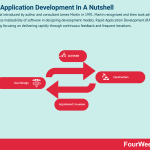
RAD was first introduced by author and consultant James Martin in 1991. Martin recognized and then took advantage of the endless malleability of software in designing development models. Rapid Application Development (RAD) is a methodology focusing on delivering rapidly through continuous feedback and frequent iterations.
Understanding Rapid Application DevelopmentIn a competitive market demanding the fast delivery of products satisfying client needs, RAD is a useful tool for many businesses. RAD allows project managers to measure and communicate progress in real-time to stakeholders. With more awareness of evolving issues and changes, projects are more transparent and run efficiently.
It’s important to note that RAD is a precursor to modern agile project management. It emphasizes rapid prototyping and iterative release cycles driven by user feedback. There is little to no emphasis on the rigid and often costly scheduling that is common to the waterfall model.
The four phases of Rapid Application DevelopmentThere are several ways to approach RAD, but many businesses choose to follow four main phases:
Phase 1 – Requirements planningPhase 1 is somewhat condensed when compared to other agile frameworks, but it is nevertheless a critical step. During this phase, stakeholders come together to set goals and expectations and brainstorm potential issues that may arise during development.
Each stakeholder must approve the project moving forward. This helps avoid costly changes because of a lack of communication.
Phase 2 – User designIn the second phase, user design must be built out via prototype iterations. Here, clients work closely with developers to ensure needs are met at every stage of the design process. In other words, the developer designs a prototype that the client tests.
Then, they come together to discuss what worked and what needs improvement. Close and iterative collaboration during the user design phase is unique to RAD, helping it deliver on a promise of fast turnaround time.
Lastly, each party must approach user design with rigor to ensure that nothing important is overlooked.
Phase 3 – Rapid constructionPrototypes and systems from the previous phase are then incorporated into a working model.
This involves:
Rapid construction preparation.Application coding.System testing.Unit integration.Software and applications are once again thoroughly tested, but during phase three there is more of a focus on refining the interface, functionality, or other aspects of the product. If new challenges are identified, then new ideas must be formulated to overcome them.
Clients may also find that theoretical ideas do not work in practice. In this case, the developer must resume prototyping or move to the final step if the feedback is completely positive.
Phase 4 – Cutover (transition)At this point, the product goes to launch and the development team moves components to a live production environment. Once this is achieved, any testing, data conversion, or user training takes place.
In the background, coders continue to look for system vulnerabilities.
Key takeaways:Rapid Application Development is a popular agile project management strategy with a focus on fast project turnaround.Rapid Application Development encourages rapid prototyping and iterative release cycles. This is achieved by the close collaboration of the developer and client at every stage of the design process.Successfully implementing Rapid Application Development largely depends on the ability of the project manager to communicate effectively with team members and stakeholders in real-time.Read Next: Business Analysis, Competitor Analysis, Continuous Innovation, Agile Methodology, Lean Startup, Business Model Innovation, Project Management.
Main Free Guides:
Business ModelsBusiness StrategyBusiness DevelopmentDigital Business ModelsDistribution ChannelsMarketing StrategyPlatform Business ModelsTech Business ModelThe post Rapid Application Development In A Nutshell appeared first on FourWeekMBA.
Dual Track Agile And Why It Matters In Business
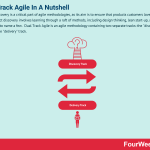
Product discovery is a critical part of agile methodologies, as its aim is to ensure that products customers love are built. Product discovery involves learning through a raft of methods, including design thinking, lean start-up, and A/B testing to name a few. Dual Track Agile is an agile methodology containing two separate tracks: the “discovery” track and the “delivery” track.
Understanding Dual Track AgileMany assume that the most important part of lean and agile methodologies is delivery velocity.
However, product discovery is equally as important in ensuring that only products customers love are built. Product discovery involves learning through a raft of methods, including design thinking, lean start-up, and A/B testing to name a few.
These somewhat traditional methods of product discovery occur as a phase. Insights are handed over to delivery teams after weeks or sometimes months of product research. During this time, user feedback can become messy as details are lost or simply incorrect. Indeed, users may not understand what they are asking for or worse still, what they actually need.
Uncovering these insights takes time and effort, which many product managers aren’t willing to commit. This leads to assumptions being made which ultimately threaten the integrity of the product.
Dual Track Agile aims to validate product ideas as quickly and cost-effectively as possible. In other words, to increase learning velocity to complement the delivery velocity characteristic of the agile approach.
The two-tracks of Dual Track AgileAs noted, Dual Track Agile incorporates two tracks:
The discovery track (team) – who gather insights, feedback, product ideas, and develop product personas based on stakeholder goals. Discoveries must be assessed in the context of market opportunities, competitor products, and user expectations.The delivery track (team) – encompassing the process many practitioners call agile development. Taking the insights provided by the discovery track, the delivery track builds and releases as many useful features as possible in a given sprint.To be effective, the discovery and delivery track must work concurrently with high collaboration between each team. There is no requirement for the discovery team to fully define all product backlog items before the delivery team can begin development.
The Dual Track Agile process is non-linear and involves the key members of each team (managers, designers, and developers) working together throughout. Ultimately, it is a balanced approach that allows the delivery team to work on one set of features while the discover team simultaneously determines what the next features should be.
Benefits of Dual Track AgileHigher quality products. During the Dual Track agile approach, only validated product ideas are allowed onto backlogs. This increases the odds that the user base will resonate with a given product feature if it is built.Lower development costs. When the discovery and delivery team work in unison, development velocity increases which reduces cost. In other words, Dual Track Agile avoids the scenario where one team is sitting idle while it waits for the other team to complete a task. This creates a streamlined and cost-effective development cycle where both teams work to well-informed and detailed plans.Adaptability. Increasing delivery velocity helps businesses adapt to fluctuating consumer trends or improvements in technology. The rapid creation of prototypes shows customers that the business is attuned to their needs and has a desire to meet those needs long term. Key takeaways:Dual Track Agile is a concurrent software development methodology with an aim to validating ideas as quickly and cost-effectively as possible.Dual Track Agile incorporates two tracks, one is occupied by the delivery team and the other by the discovery team. Both teams work simultaneously in a non-linear fashion. Key members of each team must maintain a high degree of collaboration to avoid project downtime. Dual Track Agile increases the odds of higher quality products that address real customer needs. It also lowers development costs and makes the organization more adaptable to changing market conditions.Read Next: Business Analysis, Competitor Analysis, Continuous Innovation, Agile Methodology, Lean Startup, Business Model Innovation, Project Management.
Main Free Guides:
Business ModelsBusiness StrategyBusiness DevelopmentDigital Business ModelsDistribution ChannelsMarketing StrategyPlatform Business ModelsTech Business ModelThe post Dual Track Agile And Why It Matters In Business appeared first on FourWeekMBA.
Crystal Agile Framework In A Nutshell
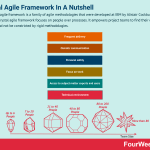
The Crystal agile framework is a family of agile methodologies that were developed at IBM by Alistair Cockburn in 1991. The Crystal agile framework focuses on people over processes. It empowers project teams to find their own solutions and not be constricted by rigid methodologies.
Understanding the Crystal agile frameworkTasked with creating a framework for software development, Cockburn instead realized that project teams owed their success to a collection of best practices. Furthermore, Cockburn noted that the performance of each team was governed by team size and the criticality and priority of the project.
The Crystal agile framework is a lightweight, flexible, and people-powered agile approach. It is based on two critical assumptions:
Teams can become more efficient by streamlining project work.Each project is unique and dynamic and requires particular strategies and methods.Crystal method family membersThe particular properties of a project fluctuate depending on the number of people involved and the level of criticality of the associated project.
For example, a small team can build a product without much status reporting and paperwork. But larger teams working on more complex projects would quickly experience communication artifacts without proper documentation.
To make this concept easier to understand, Cockburn developed family members based on size and criticality. By pointing out that each project requires a unique mix of policies, practices, and procedures, he noted that Crystal was “a set of samples that you adjust to your circumstances”.
These samples are grouped as such:
Crystal clear (up to 6 people) – for teams of up to 8 people working on fixed price, no negotiation projects.Crystal yellow (7 to 20 people) – for teams with code area ownership who incorporate feedback from real users, mission statements, and automated testing.Crystal orange (21 to 40 people) – for teams engaged in medium-sized projects lasting 1-2 years who are split according to skills. Crystal orange encompasses “traditional” agile projects with incremental development.Crystal red (40 to 80 people) – for larger projects following a traditional software development model with multiple teams.Crystal maroon (80 to 200 people) – for the largest projects requiring defined or different methods according to the needs of the software.Crystal diamond and sapphire – for critical, significant, or large-scale projects. Some projects may involve potential risks to human life.The seven principles of the Crystal agile frameworkThe Crystal agile framework is based on seven principles. Cockburn noted that the first three principles are compulsory for all projects, but the remaining four are optional.
Here is a look at each:
Frequent delivery. Code must be delivered regularly to users to ensure that the product satisfies their needs.Reflective improvement. It’s important to reflect on the work already completed. How was it performed, and why? Is there room for improvement?Osmotic communication. For information to flow freely between teams and team members, each individual must occupy the same physical space.Personal safety. Here, personal safety means that every individual feels safe to share their opinions publicly without fear of ridicule. In a crystal team, there are no stupid questions or suggestions.Focus on work. Leaders should communicate project priorities from the outset. Then, suitably skilled individuals should be given the time and space to work without distraction.Access to subject matter experts and users. There should be access to qualified personnel and users for valuable feedback that can improve the final product.Technical environment. Is the work environment fully equipped? Does it automate tests? Is it conducive to effective configuration management and frequent integration?Key takeaways:The Crystal agile framework empowers people to work autonomously and not be encumbered by rules and regulations.The Crystal agile framework is divided into colored crystal family members according to the size and criticality of the project in question.The Crystal agile framework is based on seven principles. The first three are compulsory for all crystal projects, while the remaining four are optional.Read Next: Business Analysis, Competitor Analysis, Continuous Innovation, Agile Methodology, Lean Startup, Business Model Innovation, Project Management.
Main Free Guides:
Business ModelsBusiness StrategyBusiness DevelopmentDigital Business ModelsDistribution ChannelsMarketing StrategyPlatform Business ModelsTech Business ModelThe post Crystal Agile Framework In A Nutshell appeared first on FourWeekMBA.
Buy-a-Feature Prioritization Model
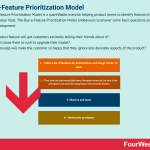
The Buy-a-Feature Prioritization Model is a quantifiable exercise helping product teams to identify features that customers value most.
The Buy-a-Feature Prioritization Model endeavours to answer some basic questions around product development:
Which product feature will get customers excitedly telling their friends about it?Which will cause them to rush to upgrade their model?Which feature(s) will make the customer so happy that they ignore less desirable aspects of the product?Understanding the Buy-a-Feature Prioritization ModelChoosing the appropriate mix of features can make or break a company, but too many product teams move ahead with product development without first involving the most important group of people: customers.
The Buy-a-Feature Prioritization Model strengthens this decision making process by incorporating valuable customer input. The model is named after the process of gathering this input, where customers are encouraged to “buy” high-priority features.
Implementing the Buy-a-Feature Prioritization ModelThere are several ways to implement the Buy-a-Feature Prioritization Model.
Regardless of which adaptation the business chooses, it’s important to conduct the exercise in person. This facilitates deeper discussion about results which gives decision makers better insight into what customers want.
Here is how the product team may conduct a Buy-A-Feature exercise:
Make a list of features for prioritization, and assign “prices” to each. Price should be relative to the cost, risk, or complexity of developing that feature. Before proceeding to the next step, every participant should be aware of the benefits of each option.Then, hand out play money (jelly beans, Monopoly money, etc.) to each of the participants and send them shopping for their favourite features. Some practitioners suggest selling one or more items at a price that no single customer can afford. This encourages customers to work together to purchase high-priority features.Observe and learn. As customers negotiate, collaborate, and discuss certain features, the product team must observe intently. Product team members are also encouraged to join the discussion, particularly if certain customers have reached an impasse on a particular feature.Review the purchases. Once every participant has spent all of their money, discuss the results in a group. How did they arrive at their decisions? Why was one item chosen over another? Why did two participants pool their money to buy a lower priority feature? In collecting insights, product teams should be as exhaustive as possible.Buy-a-Feature Prioritization Model best practicesTo increase the efficacy of this exercise, consider these best practices:
Although the Buy-a-Feature can be used with important stakeholders, the results are more significant if the end users are the primary participants. If certain product features have similar prices, then group them together. Otherwise, consider the pricing strategy carefully. For example, a participant choosing between two products with a $10 difference in price is more likely to make a subjective decision that gives no insight into the feature itself.Encourage participants to share their ideas by suggesting features or ideas not used in the exercise. For best results, ask them how they would value each feature and why.Key takeaways:The Buy-a-Feature Prioritization Model is a product prioritization technique which asks customers to “buy” features they value the most.The Buy-a-Feature Prioritization Model is performed in four simple steps. The Buy-a-Feature exercise can be performed online, but the best results are seen by conducting it in person.The Buy-a-Feature Prioritization Model is most effective when there is collaboration and interaction between product team members and participants. Certain aspects of the Buy-a-Feature exercise can be gamed to encourage this collaboration.Read Also: Kano Model, New Product Development.
Read Next: Business Analysis, Competitor Analysis, Continuous Innovation, Agile Methodology, Lean Startup, Business Model Innovation, Project Management.
Main Free Guides:
Business ModelsBusiness StrategyBusiness DevelopmentDigital Business ModelsDistribution ChannelsMarketing StrategyPlatform Business ModelsTech Business ModelThe post Buy-a-Feature Prioritization Model appeared first on FourWeekMBA.
Opportunity Scoring And Why It Matters In Business
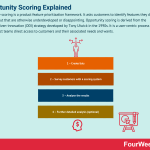
Opportunity scoring is a product feature prioritization framework. It asks customers to identify features they deem important but that are otherwise underdeveloped or disappointing. Opportunity scoring is derived from the outcome-driven-innovation (ODI) strategy developed by Tony Ulwick in the 1990s. It is a user-centric process that gives product teams direct access to customers and their associated needs and wants.
Understanding opportunity scoringOpportunity scoring is closely related to the Jobs To Be Done (JTBD) methodology, also one of Ulwick’s creations. With respect to JTBD, the key to maximum product value is determining the goals and desired outcomes of the user. In other words, what job does the product empower a user to complete?
Given the similarity of both approaches, it’s useful to think of opportunity scoring as an additional layer of JTBD. Customers are asked to identify important product features they feel are underdeveloped or indeed absent entirely. This removes the guesswork out of product design, shifting the focus from theory-based to practical-based product development.
Opportunity scoring differs from other product prioritization approaches such as the Value vs. Complexity analysis. Instead, think of opportunity scoring as an importance-versus-satisfaction analysis that seeks to make product innovation more predictable.
Conducting opportunity scoringTo conduct an opportunity scoring analysis, businesses must follow these steps:
1 – Create listsBegin by creating a list of product features and the associated results (outcomes) of each feature.
2 – Survey customers with a scoring systemThen, survey a group of customers by asking them two questions:
How important is this feature or outcome to you?How satisfied are you with how the product delivers this feature or outcome?Both questions are rated on a scale of 1-5, where 1 denotes low importance/satisfaction and 5 denotes high importance/satisfaction.
3 – Analyse the resultsAny features receiving a high importance rating coupled with a low satisfaction level should be investigated further. These will likely yield a significant ROI for the business but in any case, product teams must also consider the associated costs of seizing such an opportunity.
Features deemed low importance and low satisfaction can be ignored or removed altogether. This frees up resources to enhance other product features.
4 – Further detailed analysis (optional)When scoring product features, opportunity scoring gives importance and satisfaction equal weight. However, some product teams may choose to borrow concepts from Ulwick’s ODI methodology. In this case, the value of user importance is doubled in relation to satisfaction
With an emphasis on gauging the outcomes customers value most, a thorough understanding of their goals and motivations is crucial. Again, the features or outcomes most suited to innovation are those that have high importance values coupled with low satisfaction values.
Key takeaways:Opportunity scoring is a product prioritization framework. It asks customers to score features based on their relative importance and how satisfied they are with each.Opportunity scoring is closely related to the Jobs To Be Done (JTBD) methodology, which has a focus on understanding the goals and desired outcomes of the end user.Opportunity scoring is an importance-versus-satisfaction analysis that seeks to make innovation more predictable. Product teams can deepen the analysis by giving importance values double weight.Read Also: Jobs-To-Be-Done.
Read Next: Business Analysis, Competitor Analysis, Continuous Innovation, Agile Methodology, Lean Startup, Business Model Innovation, Project Management.
Main Free Guides:
Business ModelsBusiness StrategyBusiness DevelopmentDigital Business ModelsDistribution ChannelsMarketing StrategyPlatform Business ModelsTech Business ModelThe post Opportunity Scoring And Why It Matters In Business appeared first on FourWeekMBA.
Dynamic Systems Development Method
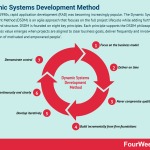
During the 1990s, rapid application development (RAD) was becoming increasingly popular. The Dynamic Systems Development Method (DSDM) is an agile approach that focuses on the full project lifecycle while adding further discipline and structure. DSDM is founded on eight key principles. Each principle supports the DSDM philosophy that “best business value emerges when projects are aligned to clear business goals, deliver frequently and involve the collaboration of motivated and empowered people”.
Understanding the Dynamic Systems Development MethodWhile RAD allowed developers to quickly showcase potential solutions with prototypes, the process itself was unstructured. Each organization built its own framework with various exacting standards, making it very difficult to recruit competent RAD practitioners.
In response, DSDM was created to give software development more governance and stricture guidelines. These changes would ultimately increase cohesion and consistency in the industry by the joint development and promotion of a singular RAD framework.
The eight key principles of DSDMDSDM is founded on eight key principles. Each principle supports the DSDM philosophy that “best business value emerges when projects are aligned to clear business goals, deliver frequently and involve the collaboration of motivated and empowered people”.
It’s important to note that compromising on any one of the eight principles undermines the philosophy and effectiveness of DSDM.
The eight principles are:
Focus on the business model. Every project team must work according to the business case and not treat the project as an end to itself. MoSCoW prioritization can help teams gain clarity in this regard.Deliver on time. Timeboxing should be incorporated at all times – even in projects without a fixed schedule or end date. Self-imposed deadlines help a team create a predictable delivery schedule that boosts morale through small and frequent wins.Collaborate. Collaboration between team members and key stakeholders is key to creating dynamic and effective cultures.Never compromise quality. Quality standards should be defined and agreed upon before project commencement. Then, they must be maintained through continuous testing, documentation, and review.Build incrementally from firm foundations. Project teams need to do enough design work upfront (EDUF) to build incrementally and avoid doing more work than is required.Develop iteratively. DSDM encourages iterative development based on client, user, and stakeholder feedback. Iterative development targets must be set with respect to the project environment.Communicate continuously and clearly. Where possible, DSDM suggests face-to-face meetings or workshops daily. Roles and responsibilities must be clearly defined. Documentation must be lean and produced in a timely fashion. This promotes highly transparent projects where stakeholders feel that their particular needs are heard, understood, and catered for.Demonstrate control. Project managers and team leaders must be able to demonstrate and communicate control of the project. In other words, the project is fully aligned with company objectives. Control also means that project managers track important metrics periodically to maintain project viability.DSDM project management best practicesBusinesses who want to use DSDM in a new project should consider these best practices. Given that DSDM is one of the early agile approaches, lessons learned here can be applied to most other agile frameworks.
Best practices include:
Ensuring that there is the complete and total buy-in for DSDM from senior management, employees, team leaders, and stakeholders alike.Creating teams who have the power to make decisions autonomously, thereby avoiding delays as a result of tedious proposal and approval processes. Teams should also be given everything they need to succeed, including the relevant equipment, environment, and project management tools.Being somewhat ruthless about prioritizing the needs of a project. To stay on time and budget, project teams need to be able to make tough decisions and scrap low priority tasks.Key takeaways:The Dynamic Systems Development Method is an agile approach that adds structure and discipline to rapid application development (RAD).The Dynamic Systems Development Method is based on eight key principles that guide the creation of business value. However, project teams must follow all eight principles to avoid compromising the effectiveness of the DSDM philosophy.The Dynamic Systems Development Method incorporates best practices that are useful in many subsequent agile frameworks. They include total stakeholder buy-in, autonomous project teams, and ruthless task prioritization.Read Next: Business Analysis, Competitor Analysis, Continuous Innovation, Agile Methodology, Lean Startup, Business Model Innovation, Project Management.
Main Free Guides:
Business ModelsBusiness StrategyBusiness DevelopmentDigital Business ModelsDistribution ChannelsMarketing StrategyPlatform Business ModelsTech Business ModelThe post Dynamic Systems Development Method appeared first on FourWeekMBA.
Test-Driven Development In A Nutshell
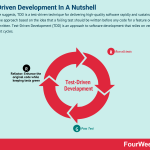
As the name suggests, TDD is a test-driven technique for delivering high-quality software rapidly and sustainably. It is an iterative approach based on the idea that a failing test should be written before any code for a feature or function is written. Test-Driven Development (TDD) is an approach to software development that relies on very short development cycles.
Understanding Test-Driven DevelopmentTest-Driven Development has had a significant influence on software design, with a particular focus on non-functional requirements such as usability, security, and maintainability.
These small tests allow developers to design systems from scratch, adding value rapidly and increasing confidence in the system itself.
A typical Test-Driven Development cycleTDD invariably follows the “Red-Green-Refactor” cycle, described as follows:
Start by adding a test unit to the test suite. This test unit should describe an aspect of the program. (Red) Run all tests, which should fail because the program lacks that feature.(Green) Write just enough code in the simplest way possible to enable the test to pass. This step is sometimes called “make it pass”.Run all tests once again.(Refactor) Enhance the original code while keeping tests green. Ensure that a focus on simplicity is maintained.Repeat and accumulate unit tests over time.Strengths and weaknesses of TDDStrengthsIncreased code quality resulting from the reduction in defects and errors. TDD forces developers to consider the purpose and specification of code. It also helps developers simplify code writing and avoid complex code that can harbor bugs. Lastly, TDD refactoring ensures that code changes or new code do not impact the integrity of the existing code.Reduction in batch size. In other agile methodologies, developers work on a feature until completion with little input from others. TDD encourages the developer to reduce the batch size to improve project visibility, flexibility, and stakeholder collaboration. Ultimately, this also makes TDD a customer-centric agile process.Encourages high developer morale. On occasion, developers become demoralized in the face of large and complex projects. TDD distills large projects into many smaller pieces that deliver quick and relatively easy wins for the developer. In addition to improving morale and confidence, the developer knows what has been completed and what work remains to be completed.WeaknessesMay take more time to implement initially. Programmers who have become accustomed to writing code that can be run immediately may find TDD slow and difficult to implement. The same can be said for programmers who have never written tests in the first place. However, any perceived slowness is an illusion at best. Although TDD may take some getting used to, it does deliver significant benefits to efficiency as development progresses.Poorly maintained or abandoned test suites. A lack of test suite maintenance can lead to a TDD cycle with a prohibitively long running time. Test suites may be also be abandoned or seldom run because of poor maintenance or changes to team composition.Key takeaways:Test-Driven Development is an agile software development approach that favors the rapid delivery of very short development cycles.Fundamental to Test-Driven Development is the “Red-Green-Refactor” test cycle. TDD argues that fail tests should be conducted before any feature or function code is written.Test-Driven Development increases code quality and developer morale while reducing batch sizes. However, some project teams may experience a steep initial learning curve – particularly if they are unaccustomed to the methodology.Read Next: Business Analysis, Competitor Analysis, Continuous Innovation, Agile Methodology, Lean Startup, Business Model Innovation, Project Management.
Main Free Guides:
Business ModelsBusiness StrategyBusiness DevelopmentDigital Business ModelsDistribution ChannelsMarketing StrategyPlatform Business ModelsTech Business ModelThe post Test-Driven Development In A Nutshell appeared first on FourWeekMBA.
The Standard for Portfolio Management
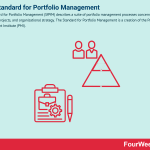
The Standard for Portfolio Management (SfPfM) describes a suite of portfolio management processes concerning programs, projects, and organizational strategy. The Standard for Portfolio Management is a creation of the Project Management Institute (PMI).
Understanding The Standard for Portfolio ManagementIn compiling a list of portfolio management processes, the PMI ensured that each approach satisfied two criteria:
They must be “generally recognized” in the sense that knowledge and practices apply to most portfolios most of the time. There must also be relatively widespread agreement regarding their value and usefulness.They must be “good practice”, with general agreement that the combination of tools, skills, and techniques can contribute to the success of many different portfolios. Here, good practice does not mean that knowledge or methods are applied uniformly. There is still a requirement that portfolio managers identify what is most appropriate to their needs.The Standard for Portfolio Management also details a common vocabulary that professionals can use when discussing or applying aspects of portfolio management.
The Standard for Portfolio Management definitionsHere are some of the core definitions of SfPfM:
Portfolio – a collection of programs and projects grouped to facilitate the completion of work in meeting strategic goals and objectives. Projects and programs do not need to be related or interdependent.Portfolio management – the coordinated and continuous management of one or more portfolios using interrelated processes that support decision making. The business must consistently evaluate, prioritize, and allocate resources to ensure that portfolios meet strategic goals.Aligning Process Group – a group of individuals that determine how portfolio components will be categorized, evaluated, and managed for potential inclusion in a portfolio.Monitoring and Controlling Process Group – who periodically review portfolio KPIs to determine whether they are contributing to company success.Portfolio management and organizational strategyThe PMI note that the ultimate goal of SfPfM is to link it with organizational strategy to establish a business plan that is both balanced and executable.
Businesses can develop this plan by addressing six different areas:
Maintaining portfolio alignment. While each portfolio should be aligned to strategic objectives, this alignment cannot occur if the business does not understand what its objectives are. Each new or pre-existing portfolio component must support the fulfillment of company strategy.Allocating financial resources. Resource allocation is tied to the prioritization of portfolio components.Allocating human resources. High-priority portfolio components receive funding for resource planning, recruitment, scheduling, and the training or upskilling of talent long-term.Allocating material or equipment resources. Each component must be allocated information, equipment, or space. This includes capital investment to ensure that the needs of each component are met at the organizational level – including needs related to constraints.Measuring portfolio component performance. Portfolio performance must only be measured in the context of whether the portfolio helped achieved a strategic goal.Managing risk. Each component should be routinely evaluated for internal and external risks that might prevent strategic goals from being achieved.Key takeaways:The Standard for Portfolio Management describes a suite of best practices for portfolio management with respect to projects, programs, and organizational strategy.The Standard for Portfolio Management defines vocabulary that portfolio managers can use in their professional careers. SfPfM uses a combination of well-established and process-specific terms.The Standard for Portfolio Management is predominantly focused on helping businesses attain goals and objectives. This can be facilitated by considering six key areas that detail resource allocation, alignment, and risk management.Read Next: Business Analysis, Competitor Analysis, Continuous Innovation, Agile Methodology, Lean Startup, Business Model Innovation, Project Management.
Main Free Guides:
Business ModelsBusiness StrategyBusiness DevelopmentDigital Business ModelsDistribution ChannelsMarketing StrategyPlatform Business ModelsTech Business ModelThe post The Standard for Portfolio Management appeared first on FourWeekMBA.
Sociocracy In A Nutshell
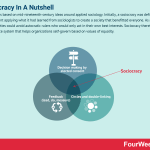
Sociocracy is based on mid-nineteenth-century ideas around applied sociology. Initially, a sociocracy was defined as a government applying what it had learned from sociologists to create a society that benefitted everyone. As a result, societies could avoid autocratic rulers who would only act in their own best interests. Sociocracy therefore is a governance system that helps organizations self-govern based on values of equality.
Understanding sociocracyIn business, sociocracy is a systems-based governance approach that advocates employee empowerment, autonomy, and self-expression. This allows employees to work in alignment with company goals and strategies while maintaining their individuality at the project level. In this way, a sociocracy is a participatory form of decision making that differs from the traditional vertical (hierarchical) management system.
Sociocracy is based on certain methods, principles, and structures that create resilient and coherent systems. In the next section, we will discuss these in more detail.
The three pillars of sociocracySociocratic principles are realized through three key features, known as pillars.
1 – Decision making by elected consentDecision-making is performed by consent, with all circle members engaged collaboratively to choose an elected person from among their peers.
Each member argues in favor of the person they consider the most competent, and each member must provide consent for the same individual to reach group consensus. However, consensus in a sociocracy means that no circle member feels the need to oppose a decision by way of a reasoned objection.
Note also that decisions are not made by an authority, traditional hierarchy structure, or majority vote.
2 – Circles and double-linkingThe organization of working groups, units, or departments is represented by nested, hierarchical circles. Here, hierarchical refers to domains of authority. There is no relationship to control, power, or coercion.
During meetings, circle members function as equals and each circle elects a secretary, facilitator, chair, and leader. Day-to-day decisions are made by the leader, but the leader is governed by a policy formulated by every member of each circle.
Each circle is linked to both a parent and sub-circle via a double link, otherwise known as an overlap. This overlap occurs when one or two members of one circle become elected delegates in the parent circle. In other words, they are full participating members of both circles. Delegates work closely with parent circle (operational) leaders to ensure that their specific needs, goals, or proposals are duly considered.
3 – FeedbackFeedback is a critical part of all activities and roles at each level of the organization. It should be given by all employees and not concentrated on those with seniority or title.
In a sociocracy, feedback takes the form of meaningful information about the functioning of an organization. It should be collected systematically and cyclically using the lead-do-measure principle:
Lead – plan a meeting and then make policy. This includes the collaborative creation of an agenda and even trivial details such as where and when the meeting will take place.Do – perform the meeting and carry out policy. Sociocracy advocates the use of rounds, where each member of the circle has a chance to speak once per round of discussion. This fosters mutual understanding and teaches employees listening skills.Measure – evaluate the meeting and evaluate policy. Evaluating the effectiveness or quality of the meeting itself is a core component of sociocracy. The secretary of the circle should record the minutes and suggest issues or topics for discussion in subsequent meetings.Feedback should always focus on whether the function in question was able to move the circle closer to its goals.
Key takeaways:Sociocracy is an organizational governance system with a focus on equality and continuous improvement.Sociocracy empowers employees to make their own decisions while maintaining an alignment with company goals and strategies.Sociocracy is based on three key pillars: decision making by elected consent, circles with double-links, and continuous and collaborative feedback.Read Next: Business Analysis, Competitor Analysis, Continuous Innovation, Agile Methodology, Lean Startup, Business Model Innovation, Project Management.
Main Free Guides:
Business ModelsBusiness StrategyBusiness DevelopmentDigital Business ModelsDistribution ChannelsMarketing StrategyPlatform Business ModelsTech Business ModelThe post Sociocracy In A Nutshell appeared first on FourWeekMBA.
GIST Planning And Why It Matters In Business
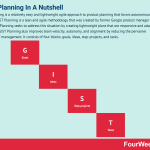
GIST Planning is a relatively easy and lightweight agile approach to product planning that favors autonomous working. GIST Planning is a lean and agile methodology that was created by former Google product manager Itamar Gilad. GIST Planning seeks to address this situation by creating lightweight plans that are responsive and adaptable to change. GIST Planning also improves team velocity, autonomy, and alignment by reducing the pervasive influence of management. It consists of four blocks: goals, ideas, step-projects, and tasks.
Understanding GIST PlanningAs a product manager, Gilad understood that there can sometimes be a mismatch between product planning and reality. While product roadmaps such as Gantt charts help to some extent, these approaches are vulnerable to change initiated by top-down management. Indeed, the net result of these directives is often the replanning or cancellation of certain projects.
The four blocks of GIST PlanningGIST is built on an acronym consisting of four blocks. Each block has a corresponding planning horizon and frequency of change.
Collectively, project teams must understand that the four blocks encompass a core planning methodology that must be followed in its entirety.
Let’s now take a look at each of the four blocks in more detail:
Goals. Where does the company want to be, and when? How will the company know when it has got there? Goals should ultimately coincide with the reasons for a company undertaking a particular project.Ideas. In GIST Planning, ideas are hypothetical ways to achieve goals. Product managers must create a dedicated idea collection system in the form of an “idea bank”. Here, brainstormed ideas are stored and then prioritized using the ICE Scoring Model or other prioritization frameworks.Step-projects. Many teams make the costly mistake of picking a promising idea and immediately executing on it. Without proper due diligence, the team ends up investing heavily in an idea that was never worth the investment. To reduce risk, each project is broken down into step-projects lasting no more than 10 weeks. Note that each step-project is an experiment that tests an idea using the Build-Measure-Learn principle. This helps teams avoid wasting resources on pointless projects.Tasks. Projects are broken down into step-projects, and step-projects are broken down into tasks that many agile practitioners will be familiar with. As a result, this block of GIST Planning does not need to change. What’s important is that the blocks above it can also behave in a somewhat agile manner.Advantages and disadvantages of GIST PlanningGIST Planning is mostly based on agile principles, but it does have some clear and unique advantages for businesses.
AdvantagesContinual generation, evaluation, and prioritization of ideas. In GIST Planning, there is no potential for one bad idea (followed without due diligence) to stymie 5 great ideas. With less emphasis on the arbitrary scheduling of ideas, businesses continually cycle through ideas to find the hidden gold. Goal-driven development. A key tenet of GIST Planning is the stipulation that ideas must further company goals. This allows decision makers to devote resources to company wide initiatives that deliver on mission or purpose-related goals.DisadvantagesShort-sightedness. The incremental and iterative nature of GIST Planning means that a business cannot commit to goals beyond a few months into the future. This compromises the ability of the organization to set goals for large projects that may take years to materialise. Ultimately, future resource planning and allocation become vague and uncertain, potentially hindering growth and agility while also making the company more reactive.Key takeaways:GIST Planning is an agile approach to project planning based on the principles of lean start-up and agile development. It favours team autonomy and velocity through a reduced management presence.GIST Planning is based on four blocks that encompass a planning methodology: goals, ideas, step-projects, and tasks. Each block runs concurrently with a specific planning horizon and frequency of change.GIST Planning advocates the continuous generation and evaluation of idea. This helps project teams avoid sinking time and money into projects that turn out to be unviable. However, businesses that adopt GIST Planning may have trouble implementing large projects that require a commitment lasting more than a few months.Read Next: Business Analysis, Competitor Analysis, Continuous Innovation, Agile Methodology, Lean Startup, Business Model Innovation, Project Management.
Main Free Guides:
Business ModelsBusiness StrategyBusiness DevelopmentDigital Business ModelsDistribution ChannelsMarketing StrategyPlatform Business ModelsTech Business ModelThe post GIST Planning And Why It Matters In Business appeared first on FourWeekMBA.



